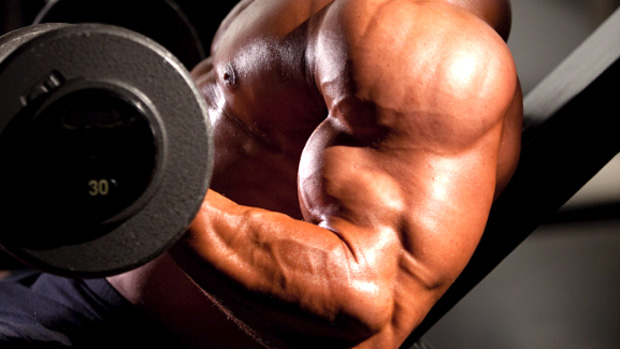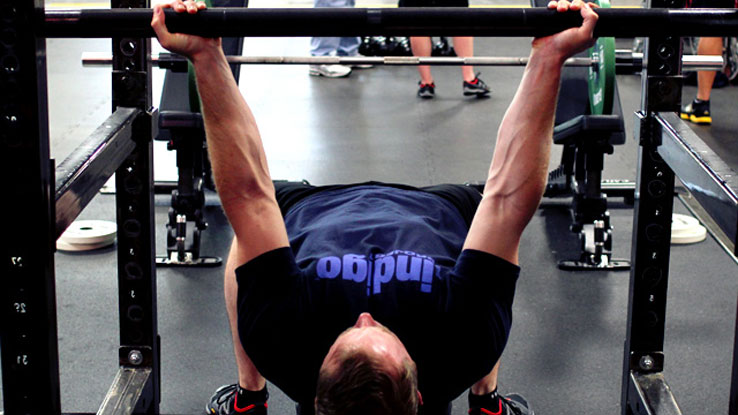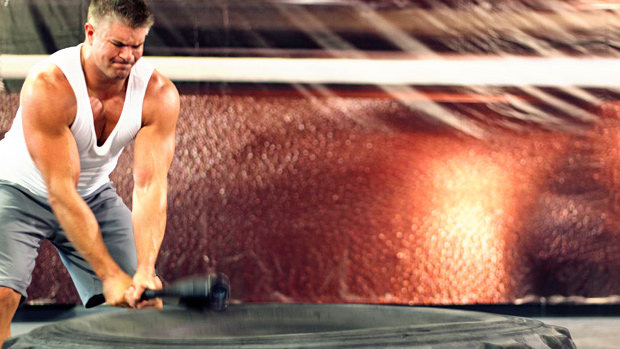Here's what you need to know...
- Bracing your abs is simple. Just bear down like you're having a bowel movement. When you brace correctly, it immediately boosts your strength during powerlifts, Olympic lifts, and many other resistance exercises.
- The "stir the pot" exercise is terrific for activating the deep core muscles while sparing the spine from unnecessary flexion.
- The side plank is an excellent core exercise to build strength in the quadratus lumborum (QL) muscles and this is important because training abs without training hip strength is useless.
- Plank and side plank variations are good for building core strength while sparing the spine, but you need hanging leg raises to build strength in the lower abdominal fibers and hip flexors.
Brace and Boost
The way you brace your midsection can have a profound effect on your performance in the gym. When you brace correctly, it immediately boosts your strength during powerlifts, Olympic lifts, and many other resistance exercises.
Bracing the abs is simple. Just bear down like you're having a bowel movement. Sure, it's not the most elegant cue to give clients, especially if you train uptight supermodels who have trouble coming to grips with the idea of delicate creatures like themselves actually having to go to the toilet. But everyone poops, and that's the most accurate cue to make sure your clients are activating all three layers of the abdominal wall and pelvic floor.
Oftentimes, people have a mental block for bearing down the midsection while they're training. When you brace correctly, the lower abs push outward, and since no one wants to look fatter than they really are, it takes some practice and psychological rewiring to make sure you're bracing correctly.
360 Degrees of Activation
Think of your midsection as being a plastic water bottle that's empty. When nothing's in the bottle it's easy to squeeze and smash it. But if you fill that plastic bottle with cement, it becomes rigid so you can't compress it. That's what happens when you bear down and increase intra-abdominal pressure (IAP) – it keeps the midsection rigid and transfers high levels of force throughout your body.
There's a simple way to determine if someone is bearing down correctly. First, have him sit on a flat bench or chair and stand behind him. Then, press your thumbs into the sides of his low back, just above the top of the pelvis. Tell him to bear down and brace. If he does it correctly, your thumbs should push outward and you'll feel equal pressure on each side. This means he's increasing IAP throughout his entire midsection. That's the goal.
Sometimes you'll feel one side develop more tension than the other. Let's say you didn't feel as much outward pressure against your thumb on the left side of his low back. Give him feedback and tell him to focus on pushing your thumb out farther on his left side the next time he bears down.
It usually takes only a few minutes of cueing to get the client to develop tension equally across both sides of his low back. Do this drill at the beginning of the workout before any strenuous lifts are performed and he'll boost his strength and protect his spine during the squat, deadlift, and many other exercises.
Importantly, the abdominal brace shouldn't trigger tension in the traps or face, and it shouldn't make you short of breath. You need to learn to brace and breathe normally.
It takes a little practice to learn to "breathe behind the shield," but usually no more than a few minutes. When you master the abdominal brace, it locks the ribcage over the pelvis and limits excess motion of the lumbar spine while training. This allows you to lift heavier weights while protecting your discs.
Three Killer Core Exercises
When it comes to core training, there are three exercises I primarily use with athletes. Each exercise serves a specific purpose and they have a powerful synergistic effect for not only boosting your performance, but also building aesthetic balance so you'll look great with your shirt off.
1 – Stir the Pot
This exercise, popularized by Stuart McGill, Ph.D., has been a mainstay in my programs since the day he showed it to me. The stir the pot is terrific for activating the deep core muscles while sparing the spine from unnecessary flexion. The key point with this exercise is to make the largest, slowest circles you can while limiting motion to the shoulder joints. The torso should not flex, bend, or twist.
2 – Side Plank With Leg Elevated
The side plank is an excellent core exercise to build strength in the quadratus lumborum (QL) muscles that attach the lower ribcage to the top of the pelvis on each side of the spine. It's notoriously weak and stiff, on one side or both, in anyone with low back pain.
It's imperative to strengthen the QL muscle in order to maintain proper pelvis alignment while training. "The true core is the pelvis," is one of the many things I learned from Chris Powers, Ph.D., a guy who knows a helluva lot about the core.
The version in the video is advanced since the top leg remains elevated throughout the hold. The leg is held elevated to also strengthen the muscles around the hip. As Powers states, "Ab training without hip strength training is useless."
3 – Hanging Leg Raise
Plank and side plank variations are good for building core strength while sparing the spine, but they don't cover all the necessary bases.
I've tested many athletes that were strong with planks but had a terrible time passing the leg-lowering test. They lacked the necessary strength in the lower abdominal fibers and hip flexors.
There are numerous ways to do the hanging leg raise, but my favorite version is with the elbows bent to 90 degrees while hanging from rings. If rings aren't an option, hang from neutral grip pull-up handles so the palms are facing each other.
Muscles that fire together, wire together. The benefit of this version of the hanging leg raise is that it builds the neural connection between the lats and abdominals so you'll become a stronger athlete. The video shows me performing the hanging leg raise at a normal speed. However, stronger athletes should perform the exercise as slowly as possible. Slower is better for this move.
Triple Threat Core Training
This core-training plan can be performed at the beginning or end of your workouts 3-6 times per week. I prefer to do it at the beginning to increase spinal stability since that'll help you lift more weight. However, if you really push the intensity of these exercises, it can have the opposite effect: your abs will be too fatigued to get the most out of your training.
In other words, there are two ways to use this workout based on your intensity -- either to increase your lifts or to really blast your abs if you're a masochist. You choose which is best for you.
Frequency: 3-6 times per week
- A1. Stir the pot for 10 slow alternating reps (5 in each direction)
- Rest 30 seconds
- A2. Side plank with leg elevated, hold each side for 30 seconds
- Rest 30 seconds
- A3. Hanging leg raise for 5 super slow reps
- Rest 30 seconds, repeat all three exercises for 3 rounds
Progression
Start with three workouts for the first week, then add one each week until you reach six workouts in week 4. Maintain that frequency for as long as you can. If you need to make the exercises more challenging, here's what you can do for each one:
- Stir the pot: Increase the number of reps or make larger circles or move slower.
- Side plank with leg elevated: Rest your elbow on a wobble board or place a mini-band around your thighs, just above the knees.
- Hanging leg raise: Perform the leg lift and lower portion more slowly or hold the top position (legs parallel to ground) for a few seconds with each rep.
A One-Two Punch
Now you have two ways to get more out of your training. First, you learned how to bear down and brace so you can add weight to your lifts by increasing IAP. Second, you have a high-performance core training routine that trains all of the essential muscles and movement patterns with only three exercises. Stick to this plan for at least a month and you'll move and look better than ever.





